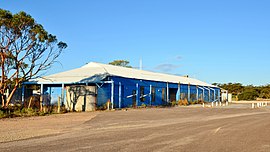Yalata, South Australia
Yalata is an Aboriginal community on the coast of South Australia. It is about 200 kilometres (120 mi) west of Ceduna. The reserve, Yalata Aboriginal Land, covers 4,580 square kilometres (1,770 sq mi) and spans about 150 km (93 mi) of the Eyre Highway. It is one of 74 local government areas in South Australia.
| Yalata South Australia | |||||||||
|---|---|---|---|---|---|---|---|---|---|
 The former Yalata Roadhouse, 2017 | |||||||||
| Coordinates | 31°29′S 131°50′E / 31.48°S 131.84°E | ||||||||
| Population | 100 (2006 census)[1] | ||||||||
| • Density | 0.022/km2 (0.057/sq mi) | ||||||||
| Established | 1994 | ||||||||
| Elevation | 90 m (295 ft) | ||||||||
| Area | 4,563 km2 (1,761.8 sq mi) | ||||||||
| Location |
| ||||||||
| LGA(s) | Aboriginal Council of Yalata | ||||||||
| State electorate(s) | Flinders[2] | ||||||||
| Federal division(s) | Grey[3] | ||||||||
| |||||||||
The people who originally live in this region are Wirangu and Mirning.[4] However, most of the people who live at Yalata are Pitjantjatjara, who originally come from the north (Anangu Pitjantjatjara Yankunytjatjara). They speak a southern dialect of the Pitjantjatjara language. This is spoken as a first language in most homes (58% in 2006).[5] The other groups making up the land's traditional owners are the Kokatha, Yankunytjatjara, Antakirinja, Pindiini and Ngalea, which are all nations of the Western Desert.[4]
Pitjantjatjara were forced to move here by the Australian government in the 1950s. Large parts of their land in the north were made into the Woomera Test Range, a weapons testing area. The families were first moved south, to a Christian mission at Ooldea. They were moved to Yalata, even further south, in 1952.[6] This second move was done because of nuclear-weapon tests being done at Maralinga and Emu Field.[7] The title to the lands around Maralinga (Maralinga Tjarutja) was given back to the Aboriginal people by the South Australian Parliament in December 1984. People from Yalata and further inland resettled on the land in 1995.
A total of 82% of residents identify their main religion as Lutheran.[5]
References
change- ↑ Australian Bureau of Statistics (25 October 2007)[permanent dead link]. Yalata (Urban Centre/Locality). 2006 Census Quickstats. Retrieved on 25 May 2008
- ↑ "District of Flinders Background Profile". Electoral Commission SA. Retrieved 9 September 2015.
- ↑ "Federal electoral division of Grey, boundary gazetted 16 December 2011" (PDF). Australian Electoral Commission. Retrieved 20 August 2015.
- ↑ 4.0 4.1 "Yalata Indigenous Protected Area". Australian Government, Department of Sustainability, Environment, Water, Population and Communities. Archived from the original on 2 February 2013. Retrieved 26 October 2012.
- ↑ 5.0 5.1 ABS 2006 Yearbook[permanent dead link]. Retrieved on 5 June 2008
- ↑ A toxic legacy : British nuclear weapons testing in Australia in: Grabosky, P N. Wayward governance : illegality and its control in the public sector. Canberra: Australian Institute of Criminology. pp. 235–253. ISBN 0-642-14605-5. Archived from the original on 2011-01-19. Retrieved 2009-06-27.
- ↑ United Kingdom Parliament, Atomic Test Site (South Australia) Archived 2012-12-27 at the Wayback Machine, House of Commons, 1 April 1993, columns 645–652, (Norman A. Godman, Member for Greenock and Port Glasgow).
Other websites
change- Yalata Community Archived 2013-04-10 at the Wayback Machine
- Yalata Indigenous Protected Area Archived 2013-02-02 at the Wayback Machine
- Atlas of South Australia Archived 2012-04-01 at the Wayback Machine
